
Contents





Love Travels Through the Strings of the Violin






Enchanted by Ulleungdo Island
Trekking on the Island of Mystery
The island of Ulleungdo is a three-hour ferry ride away, and even then it’s only accessible when the weather permits. Once you get past the rough waters, you will realize that the journey has been worthwhile. The people of Ulleungdo Island boast that the island lacks three things: thieves, pollution and snakes. On the other hand, it’s known for juniper trees, wind, beautiful women, water and stones. Its blue waters and tall rocky outcrops are absolutely stunning and captivating. Ulleungdo Island, the perfect getaway from the quotidian, opens up a whole new world of exploration.
Written by Suji Baek Photographed by Studio Kenn
Illustrated by Hagogo
Gwaneumdo Island Between Endless Waters and Lush Silver Grass
The waves break gently on the pebble beach. The rugged coast of Ulleungdo Island is lined with pebbles, boulders and strange rock formations. An hour’s drive around the coastal ring road leads you to the entrance of Gwanseon Tunnel, the gateway to Gwaneumdo Island. As the third largest island in the waters surrounding Ulleungdo Island itself, Gwaneumdo Island is an uninhabited outcropping of outstanding natural beauty.
I pay the admission fee and enter a white building about 30 meters tall. I take the elevator to the seventh floor, the highest one. Feeling the cool sea breeze on my skin, I head toward Yeondo Bridge, the interisland pedestrian walkway that connects Ulleungdo and Gwaneumdo islands. I feel a rush as the powerful waves crash upon the rocks below. The trail on Gwaneumdo passes a total of three view spots. I stop at one to enjoy the magnificent view of Ulleungdo and the small island of Jukdo. Lying far out on the northwest side is Samseonam Rock, and to the southwest is the Haengnam Coastal Walk. To the back of the island is the Gwaneumssanggul Cave, where ― legend has it ― water dripping from the roof is the key to longevity.
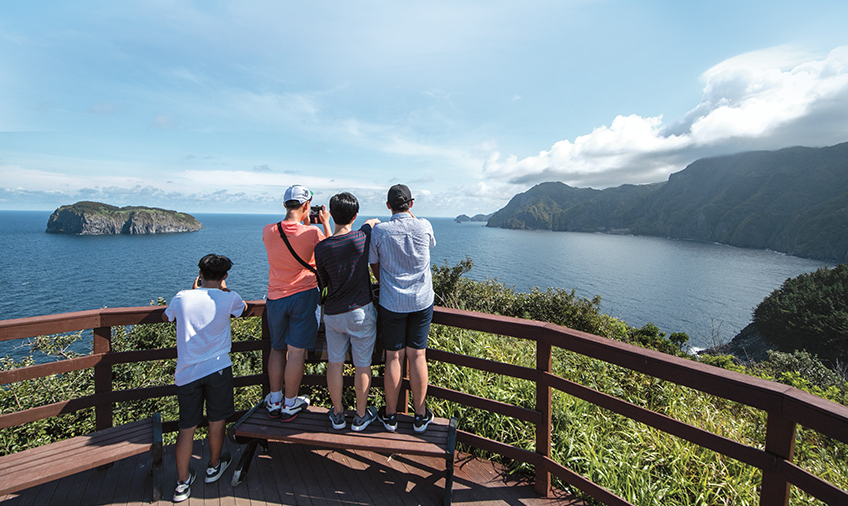 Standing on the Gwangeumdo Observatory, you can get a whole view of Jukdo, along with the ever stretching blue ocean and sky. © Ulleung-gun
Standing on the Gwangeumdo Observatory, you can get a whole view of Jukdo, along with the ever stretching blue ocean and sky. © Ulleung-gunI continue down the trail. I have blue waters on my right, and a meadow of silver grass on my left. The plumes of silver grass dance in the wind. It takes less than an hour to walk the perimeter of the island, but its autumnal beauty leaves a long-lasting impression.
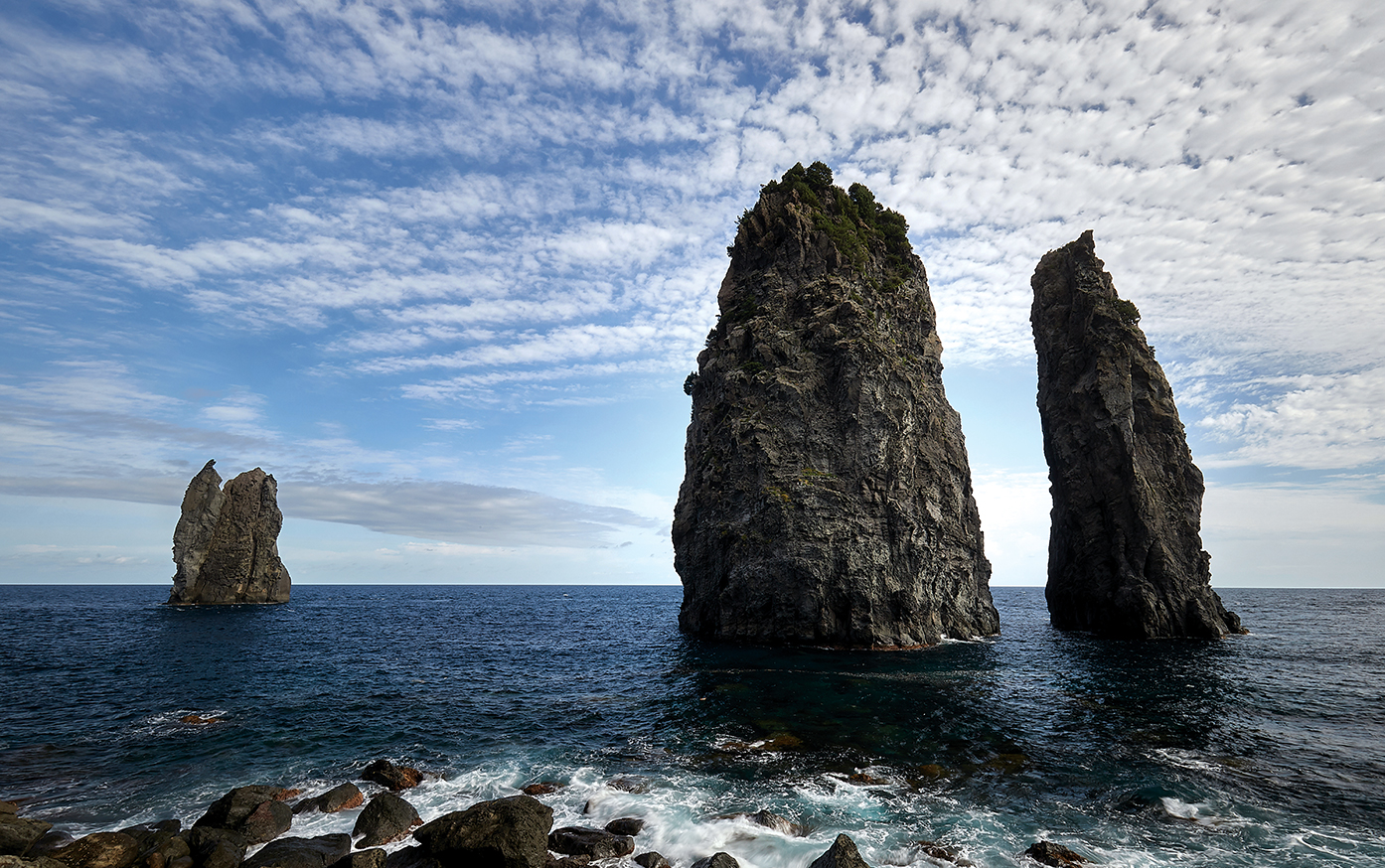 The magnificent Samseonam Rock in the middle of the ocean, standing so high, looks like it is touching the sky.
The magnificent Samseonam Rock in the middle of the ocean, standing so high, looks like it is touching the sky.Nari Basin When Berries Turn Ripe Red
I head inland to the Nari Basin, the largest flat area on Ulleungdo Island. It’s fascinating that there are people living in this caldera, which is almost 200 hectares in area. The vast plain-like basin is home to wild vegetables, such as mountain garlic, deodeok, and Amur wallflowers. In autumn, the ripening rowan berries add a dash of red to the island. The people of Ulleungdo Island use these berries to brew wine. Shingle-roofed houses, with rocks placed on top of wood shingles, and thatched-roof houses made of cornstalks and silver grass, are also common sights. These were the architectural styles prevalent in the early days of the island.
Among the many paths leading to Seonginbong, the highest peak on the island, the most beautiful is the Nari Basin Forest Trail. This path begins in the Nari Basin and passes the Albong Basin and the Sillyeongsu Mineral Spring. I’m greeted not only by old, majestic trees, like beech and Acer okamotoanum Nakai, but also a wide range of rare, endemic species, including the Ulleung chrysanthemum and the Turk’s-cap lily.
 Neowa-jib, made with wooden roof, in Nari Basin area is the architectural style prevalent in the early days of the island. It is well preserved despite the harsh weather. It was designated as North Gyeongsang Province cultural heritage in 1986.
Neowa-jib, made with wooden roof, in Nari Basin area is the architectural style prevalent in the early days of the island. It is well preserved despite the harsh weather. It was designated as North Gyeongsang Province cultural heritage in 1986.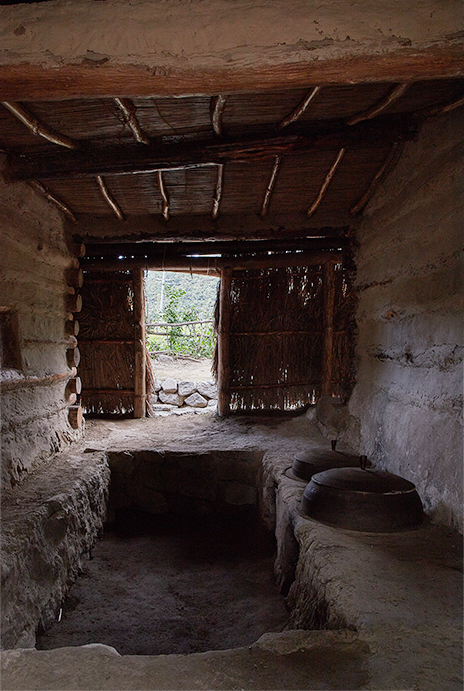
The walk has left me hungry. It’s time to dig in to a healthy meal made from fresh, local ingredients. The table is covered with a bowl of bibimbap mixed rice and seasoned vegetables as side dishes. You can literally walk into any restaurant on the island for a delicious meal. As I bite into a piece of deodeok pancake, I order a bottle of Ulleungdo pumpkin makgeolli rice wine to pair with the food.
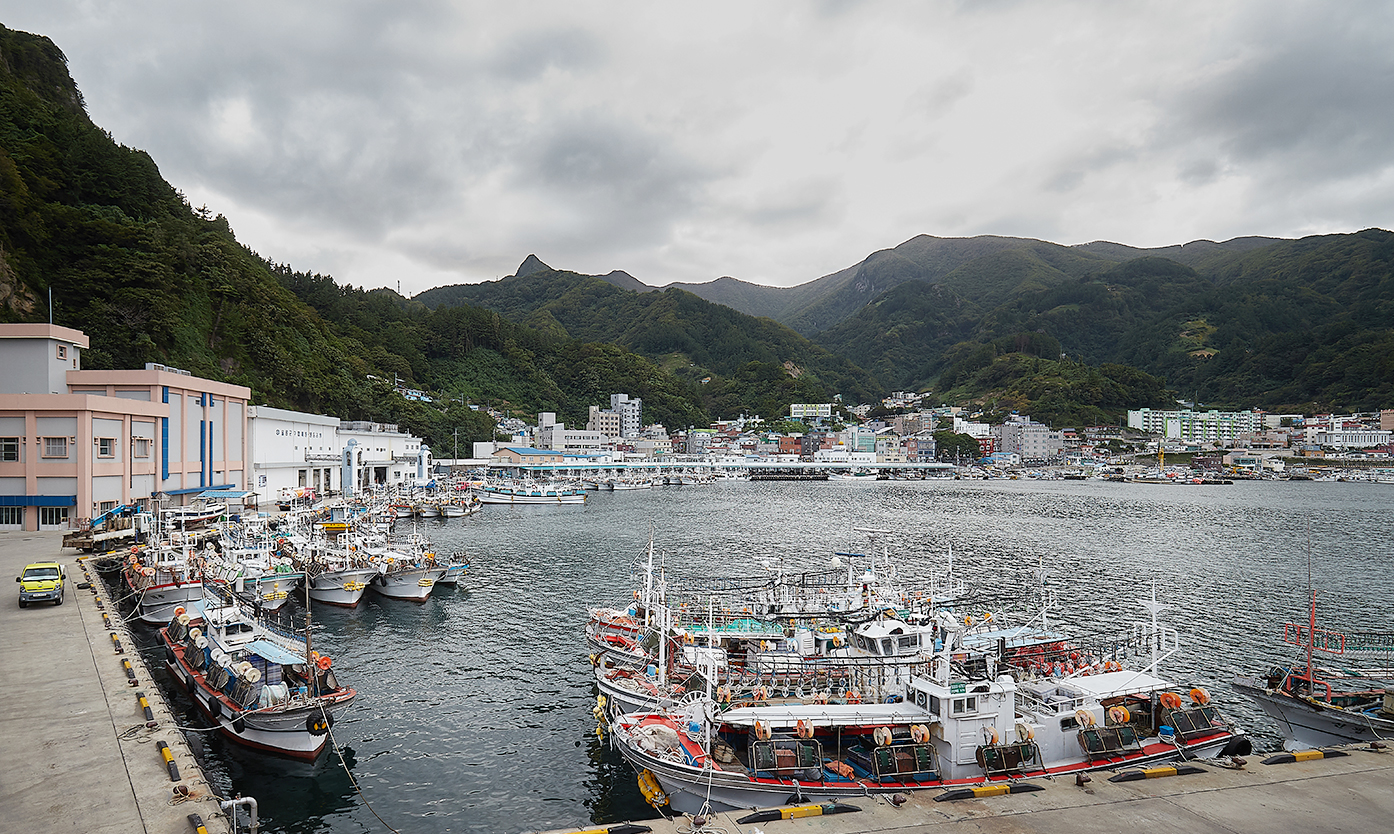 Fishing boats are docked at Jeodong Port.
Fishing boats are docked at Jeodong Port.Haengnam Coastal Walk Breathtaking Scenery of Fabulous Waves
The Haengnam Coastal Walk is a meandering path that extends from Dodong Port, home to 2,500-year-old juniper trees, all the way to Chotdaebawi Rock near Jeodong Port. The scenery that unfolds before your eyes is quite different from what you get to see inland. Throughout the two hour walk to Jeodong Port and back, you will be constantly amazed by the glorious gifts of nature, ranging from rugged cliffs to sea caves.
The iron bridge and deck overlook clear waters, and the surroundings are a sight to behold. The bizarre-shaped cliffs and massive rocks are the result of various geological processes, and also serve as evidence of volcanic activity on the island many years ago. You can spot some fish tucked away in holes in the rocks formed from the cooling of the magma.
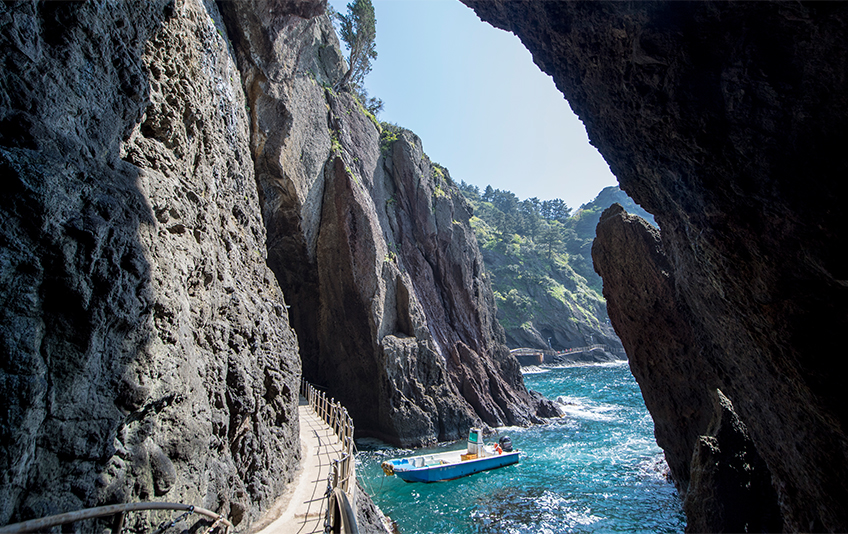 Ulleungdo Island presents beautiful nature that holds the blue sky and sea. © Ulleung-gun
Ulleungdo Island presents beautiful nature that holds the blue sky and sea. © Ulleung-gunThe Haengnam Lighthouse sits in the middle of the path between Dodong Port and Jeodong Port. In the fall, you will find scattered pine cones and bright yellow flowers of the leopard plants. The beech trees growing in the gaps of the cliffs will leave you in awe of their tenacious hold on life. By this time, you will have grown acquainted with a few seagulls that are pestering you for food.
Trip Points
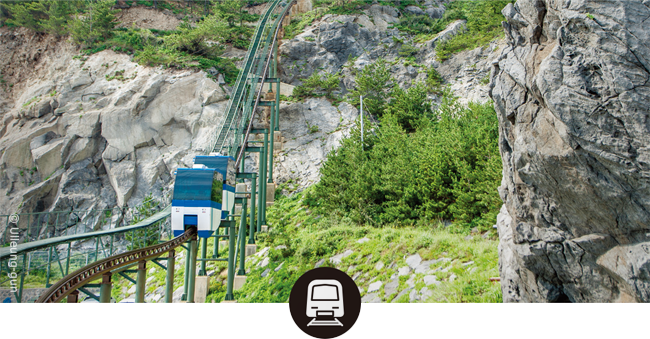
Taehahyangmok Tourist Monorail Monorail Ride With Unparalleled Scenery
A flock of seagulls welcomes me at the Taehahyangmok Tourist Monorail, which travels from the Charcoal Cave to the Taeha Lighthouse. Car No. 2 offers a bird’s-eye view of the sea all the way to the top. The observatory is just a 500-meter walk away from the mountaintop station. On this delightful path, you have the rare opportunity to see endemic species such as the Ulleung beech, Acer takesimense Nakai, Acer okamotoanum Nakai, and the Korean linden. The Ulleung camellia, with leaves more lustrous than any other variety of camellia, has walnut-sized fruit that’s ready to burst open any minute.
The path ends at the Taehahyangmok Observatory and right across from it is the Taeha Lighthouse. To the right of the observatory, the Hyeonpo Port, Songgotbong Peak and the Gongam Elephant Rock come together to form a picturesque scene. On the left, you can take in the soothing blue waters of the Daepunggam. The emerald blue is so mesmerizing that you will find it hard to look away.
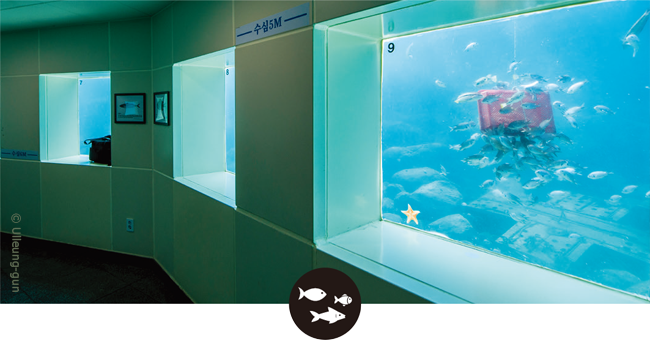
Cheonbu Underwater Observatory An Extraordinary View of Marine Life
Cheonbu Port has lost its vigor with the emergence of Dodong and Jeodong ports, but Cheonbu Underwater Observatory will show you vivid colors under the sea. Cross the bridge that connects to the Cheonbu Pocket Park, and walk about 100 meters to the end of the long pier. The cylindrical building that awaits you is the Cheonbu Underwater Observatory. This observatory has an elevator that takes you six meters beneath the surface of the waves. Through the wide windows, you can witness the full beauty of marine life. The feed bucket installed in front of one of the windows attracts a variety of fish, such as yellowtail, blowfish and filefish.
The perfect hour is the moment when the sky turns blue before the sun completely sets in the evening. I catch a glimpse of this “blue hour” as I exit the observatory, but, soon enough, the sun dips below the western horizon. Silence descends over the port.
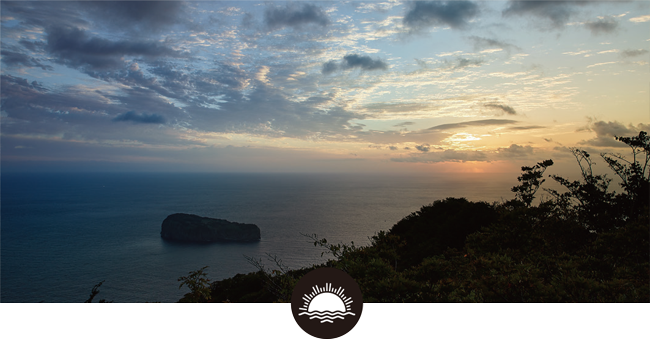
Naesujeon Sunrise Observatory Spectacular Sunrise Spot on the East End
In the wee hours of the morning, I make my way to the Naesujeon Sunrise Observatory, just five minutes away from Jeodong Port by car. As you can tell by the name, it’s one of the best sunrise spots on Ulleungdo Island. After a 15-minute climb up a wooden stairway lined with rowans and camellia, you will arrive at the observatory that sits 440 meters above sea level. On the left, you get a view of Jukdo, Gwangeumdo island and the Seommok coast. On the right is Jeodong Port with its squid boats and hordes of seagulls. The famous Chotdaebawi Rock also comes into sight.
The sun rises at 5:48 a.m. on this day. This is where you can catch one of the earliest sunrises in Korea. Perhaps that is why this moment feels all the more precious. I’m impressed by the red and orange hues that stretch across the horizon. The scene harnesses the beauty of blank space, as if to refl ect upon the leisurely pace of life on the island. The grandeur of the Seonginbong Peak, glimmering in the morning sun, is an added bonus.

Dokdo Observatory Cable Car Only 87.4 km From the Solitary Island of Dokdo
The Dokdo Observatory is an attraction not to be missed. On a fine day, you can look out to Dokdo Island, which is just under 90 km away. At sunrise and sunset in the winter, Dodong Port is bustling with squid boats heading out to sea. Manghyangbong Peak is easily accessible by cable car from the Dodong Mineral Spring Park.
Upon arriving at the observatory, 340m above sea level, I get a panoramic view of Dodong Port and Seonginbong, the highest peak on the island. It’s said that Dokdo Island can be seen with the naked eye on a clear day, but the weather was not in my favor that day. With my yearning for Dokdo still burning strong, I decide to drop by the Dokdo Museum, which is right next door. A visit to the museum is highly recommended to those wanting to learn more about Dokdo.

Travel Tip
-
Ulleung Tourism Information Desk
- Address : 66, Dodong 2-gil, Ulleung-eup, Ulleung-gun, Gyeongsangbuk-do
- Tel : +82-54-791-2191
- Hours: 09:00-18:00
Gwaneumdo Island
- Address : Cheonbu-ri, Buk-myeon, Ulleunggun, Gyeongsangbuk-do
- Tel : +82-54-791-6022
- Hours :
08:00-19:00 (From April to Oct.),
09:00-17:00 (From Nov. to March) -
Korea Travel Hotline
- Tel : 1330
Nari Basin
- Address : Nari 1-gil, Buk-myeon, Ulleung-gun, Gyeongsangbuk-do
- Tel : +82-54-790-6423Cheonbu Underwater Observatory
- Address : 718-54, Cheonbu-ri, Buk-myeon, Ulleung-gun, Gyeongsangbuk-do
- Tel : +82-54-791-6983
- Hours : 09:00-17:00Naesujeon Sunrise Observatory
- Address : 33, Jeodong-ri, Ulleung-eup, Ulleung-gun, Gyeongsangbuk-do
- Tel : +82-54-790-6454 -
Haengnam Coastal Trail
- Course :
Dodong port~(0.6km)Haengnam rest area~(0.5km)Haengnam Lighthouse~(0.4km)Sora stairs~(1.1km) Chotdaebawi
- Lead time : 1.5 hoursTaehahyangmok Tourist Monorail
- Address : 236, Taeha-gil, Seo-myeon, Ulleung-gun, Gyeongsangbuk-do
- Tel : +82-54-790-6638
- Hours : 09:00-17:30 (Ticketing: 09:00-16:30)Dokdo Observatory Cable Car
- Address : 99, Yaksuteo-gil, Ulleung-eup, Ulleung-gun, Gyeongsangbuk-do
- Tel : +82-54-790-6427
- Hours : 08:00-19:00
Other Articles





Love Travels Through the Strings of the Violin





Application of subscription
Sign upReaders’ Comments
GoThe event winners
Go


 October 2018
October 2018


